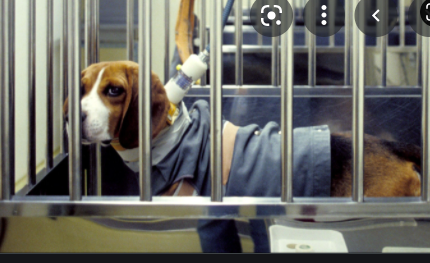The Cruelty Behind Animal Testing

December 12, 2021
“Although other animals may be different from us, this does not make them less than us” -Marc Bekoff.
Animals as living things have intrinsic rights, which are being violated by animal testing. Animal testing started in the 12th Century, by Ibn Zuhr, who was a physician, surgeon, and poet. There are many reasons why scientists use animals for testing; scientists use animals such as cats, dogs, guinea pigs, hamsters, rabbits, and mice, to test out medicine, cosmetics, and drugs. These animals are tortured, harmed, and killed in the experiments. Animal testing should be illegal. Animal testing is ineffective, it also has a negative impact on the environment, but worse of all, it’s cruel and inhumane.
Animal testing is ineffective. It is proven that animal testing is ineffective, unreliable, and it delivers imprecise results. “90% of drugs fail in human trials even though they passed preclinical tests (including animal tests) – whether on safety grounds or because they do not work” (“Arguments against animal testing”). Additionally, humans and animals are very different. Animals do not get many of the human diseases. “An analysis of over 100 mouse cell types found that only 50% of the DNA responsible for regulating genes in mice could be matched with human DNA” (“Arguments against animal testing”). Therefore, using animals for testing provides us with little statistically useful insight. If animal testing is proven to be ineffective, why is it still being used? It makes absolutely no sense to put in a lot of money and resources into a type of research that doesn’t even work; I’m sure there are many more effective methods that could definitely replace animal testing.
Animal testing has a negative environmental impact. Animal testing causes harm to our environment; more than 100 million animals are used in experiments every year. Animal waste can result in water contamination. The disposal of the animals, and the dangerous chemicals/supplies that were used in the experiments, lead to air pollution; incineration of animal carcasses is also significantly harmful to our health, it can cause chronic illnesses and lead to developmental delays in nearby populations. Not only does animal testing pose a danger to our environment, but it also poses a danger to the health of laboratory workers. Due to intense air filtration in the laboratories, the workers are exposed to extremely dangerous chemicals and experience allergic reactions and occupational asthma. The inhalation of those dangerous gases is also associated with long-term physical and mental health issues. Furthermore, animal testing is costly. “More than $16 billion of taxpayer money is spent on animal experimentation by the United States government each year” (“Facts -Laboratory Animals”). “Animal-testing is a waste of money, time, and resources that could have been spent on human-relevant research,” said PETA. There are many prominent scientists, such as Shrike Zhang, Kimberly Norman, and Kambez Benam, who have been working to reduce or eliminate animal testing by replacing it with more effective methods, because of how irrelevant, inefficient, and cruel animal-testing is.
Animal testing is cruel and inhumane. “Each year, it is estimated that more than 25 million dogs, cats, monkeys, mice, rats, and other animals are forced to endure painful experiments in the United States” (“Take Suffering Out of Science”). It is sickening to know how they treat those poor animals. “The experimenters force-feed chemicals to the animals, conduct repeated surgeries, implant wires in their brains, and crush their spines” (“Cruelty to Animals in Laboratories”). The animals are infected with deadly diseases, tiny mice grow tumors, kittens are purposely blinded, monkey’s skulls are cut open and electrodes are implanted in them, and dogs are injected with substances, or forced to inhale them. The animals are then dumped back into the cage without any painkillers whatsoever. It breaks my heart knowing that these animals have to experience deprivation, isolation, and misery every day, even though they have done absolutely nothing to us. Worst of all, these animals are then killed after the experiments. Animal testing is just straight torture, and it should have never been allowed in the first place. The reason why I’m extremely against animal-testing and cruel experiments is that I grew up with two dogs, who mean the absolute world to me. I can’t stand the fact that there are dogs and many other animals getting tortured and killed just for the benefit of us humans. I can’t imagine how much pain and suffering those animals go through every single day. I really do feel sympathy and pity for those animals. The brutality behind animal testing isn’t talked about enough. Those animals don’t deserve the inhuman treatment, animal testing should be put to an end, and be illegal in every single country.
A lot of people state that animal testing is necessary, and has benefited us in many ways; supposedly, animal research has helped save and improve millions of lives. “Animal research has helped us to make life-changing discoveries, from new vaccines and medicines to transplant procedures, anesthetics, and blood transfusions. Millions of lives have been saved or improved as a result. Animal research has been important in the development of many major medical advances”. ( Animal Research Benefits Us) Animal testing is wasteful, as I’ve stated before, most of the drugs that are tested on animals fail in human clinical trials. “The majority of animal experiments do not contribute to improving human health, and the value of the role that animal experimentation plays in most medical advances is questionable.” (Animal Experiments Are Wasteful and Unreliable) Animal testing should be illegal. Animal testing is harmful to our environment, it’s purposeless, and it’s cruel and inhumane.
The main solution would be replacing animal testing with in vitro methods and silico models. “These alternatives to animal testing include sophisticated tests using human cells and tissues (also known as vitro methods), advanced computer-modeling techniques (often referred to as silico models), and studies with human volunteers” (“In Vitro Methods and More Animal Testing Alternatives”). These methods are able to provide us with more accurate results than animal testing, and we are able to spare those poor animals.
Sources Cited:
- “Arguments against animal testing”. Cruelty-Free International.org, Arguments against animal testing | Cruelty-Free International
- “Alternatives to Animal Testing”. Peta.org, In Vitro Methods and More Animal Testing Alternatives
- “Animal Research: An Environmental Perspective”. Faunalytics.Org, Animal Research: An Environmental Perspective
- Shroff, Jai, The Significant Impact of Animal Testing on the Environment, The Significant Impact of Animal Testing on the Environment.
- “Meet the young scientists working to get rid of animal testing around the world”. National Observer, Meet the young scientists working to get rid of animal testing around the world.
- “Facts – Laboratory Animals”. Animal Matters.Org, Facts – Laboratory Animals
- “Cruelty to Animals in Laboratories”. Peta.Org, Cruelty to Animals in Laboratories.















Justin
Feb 14, 2024 at 3:57 PM
I always knew animal testing was bad, but never why. Thank you for explaining it 🙂 – Justin
Aayden
Feb 14, 2024 at 3:23 PM
Interesting article and it’s well ecplained
Tia
Feb 13, 2024 at 6:41 PM
I think this article is well written and gave me more insight into animal testing.
Dulce
Feb 2, 2024 at 2:51 PM
I really think this article is well explained nice details and explanation you gave good reasons. I love it ♥
ari
Dec 12, 2023 at 9:44 PM
This is all so sad, seeing that the world has turned to animal testing for cosmetics and such. It’s honestly so disappointing seeing posts like these on the internet. All tested animals shouldn’t need to be put through this cruel and abusive cycle of being tested on with chemicals harmful for them, however allows this shame on them. You did an amazing job addressing this problem thank you.
Christie A
Nov 9, 2023 at 12:52 PM
I love this. You did a very good job explaining this issue. I really do want this all to end.
Kai
Mar 6, 2023 at 3:00 PM
I feel this article completely covers reasons why animal testing should be illegal, therefore stopped.
Jurrel B
Jan 26, 2022 at 3:01 PM
Interesting article 🙂 yuh